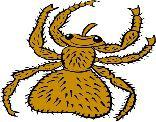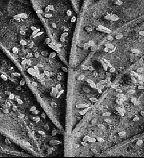Natural Solutions to Things That Bug You (5 page)
Read Natural Solutions to Things That Bug You Online
Authors: Myles Bader
APHIDS/SCALES
 Aphids are soft-bodied, pear-shaped and less than 1/10
Aphids are soft-bodied, pear-shaped and less than 1/10
inch long. They can be winged or wingless and have a pair of tiny tubes at the end of their abdomen. The immature stages of these insects are very similar to the adult; however, they lack wings. They can be found in almost any color and will suck the sap from the plant. Scales are usually reddish-brown, round-shaped orange circles with a small knob in the center of a cap-like covering. They are only 1/12
inch long.
GRASSHOPPERS/CRICKETS/KATYDIDS/MANTIDS
 The immature stages and the adult are very similar with the exception of fully developed wings in the adult.
The immature stages and the adult are very similar with the exception of fully developed wings in the adult.

TERMITES
The only noticeable difference between the immature stage and the adult will be the size. The reproductive forms of termites have large functional wings and distinct wing buds in their early development stages.

TICKS/SPIDER MITES
After their eggs hatch, ticks have six legs in their larval stage. After they molt they have 8 legs and look like an adult until they complete their development. To check a plant for mites you will need a magnifying glass. Mites can reproduce every 3-7 days and are not insects. To control them spray the plant every few days since they won’t multiply if the area is kept damp.

WHITEFLY
This small white fly is difficult to control since they will leave the plant as soon as you spray the plant. It is best to identify the immature stage, which is scale-like and can’t move. The scale can be eliminated with dipping in a soapy solution.
GARDENER-CAUSED PLANT DISEASE
Care must be taken when handling or touching plants in the garden, especially wet plants. Disease: can be spread by just touching an area that is diseased and then touching another plant.
If you see a diseased area, just remove it, destroy it and wash your hands before continuing with your gardening. Some diseases live in the soil and are easily transmitted to your plants. The problem may not be from insects. Good soil enrichment by compost will be the key to reducing many plant diseases.
The following are a few more rules to follow
Keep the area around your plants clean and clear of any rotting debris
Plow the garden area in the fall to plow the old plants under and remove locations for pests to winter
Plowing will also allow some of the insects and their eggs to become more visible for the birds to see and eat
Cover the rows with cheesecloth netting to deter Japanese beetles and similar bugs
GENERAL GUIDELINES FOR HOUSE PLANTS
Be sure and use clean pots & planters when you re-pot a plant.
Use only sterile potting soil since garden soils may contain insect larvae or other harmful components.
Be sure and isolate any newly purchased plant for around 30 days while checking them frequently for signs of disease or insects.
If you are going to bring any plants that have been outside for the summer in the house, be sure to check them over carefully.
Be sure and use a magnifying glass to look for insects.
Wash the leaves occasionally with a soft cloth and warm, soapy water.
Be sure the air is circulating freely around the plants.
Nutrient sticks work very well to feed a plant and keep it healthy so that it can fight off disease and insects.
NATURAL METHODS OF CONTROL
Removing the pest by hand picking
Introducing parasites to eat the pests from the inside
The use of a natural predator to eat the pest
Microbes that will make a pest sick
Removing debris, eliminating their living quarters
Planting protective plants to repel them
Trapping the pest using “pheromone”

Crop rotation
INSECT-CAUSED PLANT DISEASE
 There are many plant diseases caused by insects. Houseplants are especially susceptible to white flies and aphids that will suck the juices from the plants by piercing the plants leaves and stem. They are capable of transmitting viruses and bacteria into the plant from their saliva. The damaged areas may also decay, making these areas more susceptible to other airborne diseases. Certain soap sprays can alleviate this problem and prevent damage.
There are many plant diseases caused by insects. Houseplants are especially susceptible to white flies and aphids that will suck the juices from the plants by piercing the plants leaves and stem. They are capable of transmitting viruses and bacteria into the plant from their saliva. The damaged areas may also decay, making these areas more susceptible to other airborne diseases. Certain soap sprays can alleviate this problem and prevent damage.
FREEZE THEM OR HEAT ’EM UP
Before we had hundreds of poisons and pesticides, we had other methods of dealing with pests and insects.
Using very high heat or very low temperatures will kill most insects and pests. Subzero or high heat, such as 140
F or above will usually do the trick. When grandma wanted to protect her woolens and furs, she placed them in cold storage for the summer.
In Europe exterminators blow hot air at a temperature of 150
F or higher into homes and apartments to get rid of the pests. Using your furnace or freezer, you too can duplicate some of the methods that worked in the past. However, it is not really safe to try and get your furnace up over 150
F without doing damage to some fabrics and even flooring.
BUGS LOVE TO EAT CLOTHING
 Prevention can save a fortune in clothing! Best to rotate your clothes and wear them as often as possible, especially woolens. This may eliminate moths and silverfish from eating them. If you are not going to wear clothes for an extended period of time, it is best to have them dry cleaned and place them in a protective bag. If you have a woolen garment in your closet over 2 years, it would be best to examine it carefully, then send it to the cleaners and protect it.
Prevention can save a fortune in clothing! Best to rotate your clothes and wear them as often as possible, especially woolens. This may eliminate moths and silverfish from eating them. If you are not going to wear clothes for an extended period of time, it is best to have them dry cleaned and place them in a protective bag. If you have a woolen garment in your closet over 2 years, it would be best to examine it carefully, then send it to the cleaners and protect it.